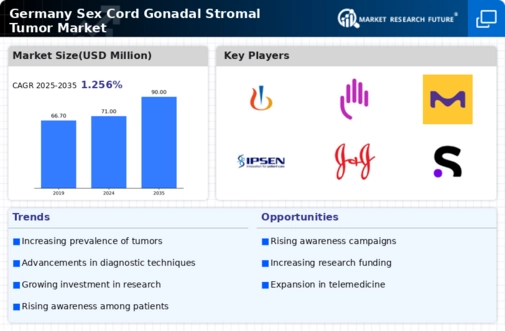Increasing Incidence Rates
The sex cord-gonadal-stromal-tumor market is experiencing a notable increase in incidence rates within Germany. Recent data indicates that the prevalence of these tumors is rising, with an estimated annual increase of approximately 5% in diagnosed cases. This trend is likely attributed to improved diagnostic techniques and heightened awareness among healthcare professionals. As more cases are identified, the demand for specialized treatment options and healthcare services is expected to grow, thereby driving market expansion. Furthermore, the increasing incidence may lead to greater investment in research and development, as stakeholders seek to understand the underlying causes and develop effective therapies. Consequently, the rising incidence rates are a critical driver for the sex cord-gonadal-stromal-tumor market, influencing both clinical practices and healthcare policies in Germany.
Enhanced Diagnostic Technologies
Advancements in diagnostic technologies are significantly impacting the sex cord-gonadal-stromal-tumor market. The introduction of innovative imaging techniques, such as MRI and CT scans, has improved the accuracy of tumor detection and characterization. In Germany, the adoption of these technologies has led to earlier diagnosis, which is crucial for effective treatment outcomes. Moreover, the integration of genetic testing and biomarker analysis is providing deeper insights into tumor behavior, allowing for personalized treatment approaches. As healthcare providers increasingly utilize these advanced diagnostic tools, the market is likely to witness a surge in demand for targeted therapies and specialized care. This trend underscores the importance of technological advancements in shaping the future landscape of the sex cord-gonadal-stromal-tumor market.
Regulatory Framework and Support
The regulatory environment in Germany plays a crucial role in shaping the sex cord-gonadal-stromal-tumor market. Recent initiatives by health authorities to streamline the approval process for new therapies are fostering a more conducive atmosphere for market growth. Regulatory bodies are increasingly recognizing the need for expedited pathways for rare diseases, which may include sex cord-gonadal-stromal tumors. This supportive framework not only encourages pharmaceutical companies to invest in research but also enhances patient access to innovative treatments. As regulations evolve to accommodate the unique challenges posed by rare tumors, the sex cord-gonadal-stromal-tumor market is likely to benefit from increased product availability and improved treatment options.
Rising Patient Advocacy and Support Groups
The emergence of patient advocacy and support groups is significantly influencing the sex cord-gonadal-stromal-tumor market. In Germany, these organizations are raising awareness about the challenges faced by patients and their families, thereby fostering a community of support. They play a vital role in educating the public and healthcare professionals about these rare tumors, which can lead to earlier diagnosis and treatment. Additionally, advocacy groups often collaborate with researchers and healthcare providers to promote clinical trials and research initiatives. This growing network of support is likely to enhance patient engagement and drive demand for specialized care, ultimately contributing to the expansion of the sex cord-gonadal-stromal-tumor market.
Growing Investment in Research and Development
Investment in research and development (R&D) is a pivotal driver for the sex cord-gonadal-stromal-tumor market. In Germany, both public and private sectors are allocating substantial funds to explore novel treatment modalities and improve existing therapies. Recent reports suggest that R&D expenditure in oncology has increased by over 10% annually, reflecting a commitment to advancing knowledge and treatment options for rare tumors. This influx of funding is likely to facilitate clinical trials, enhance collaboration among research institutions, and foster innovation in therapeutic strategies. As a result, the sex cord-gonadal-stromal-tumor market is poised for growth, driven by the continuous pursuit of scientific breakthroughs and improved patient outcomes.
























Leave a Comment